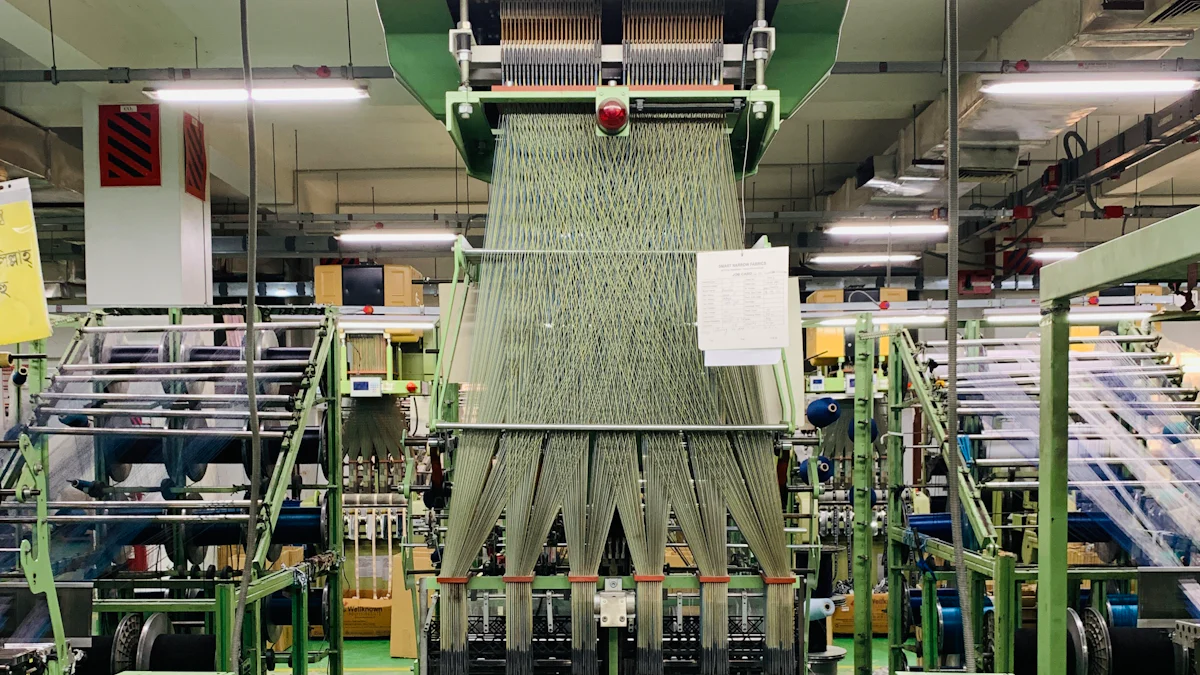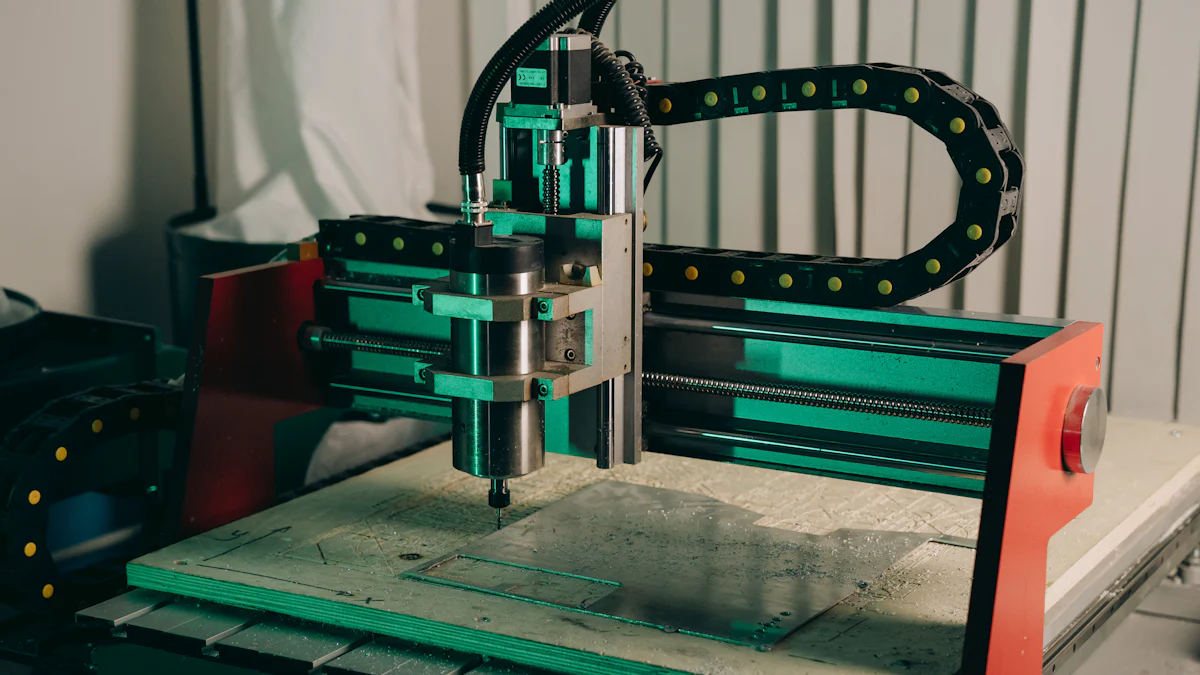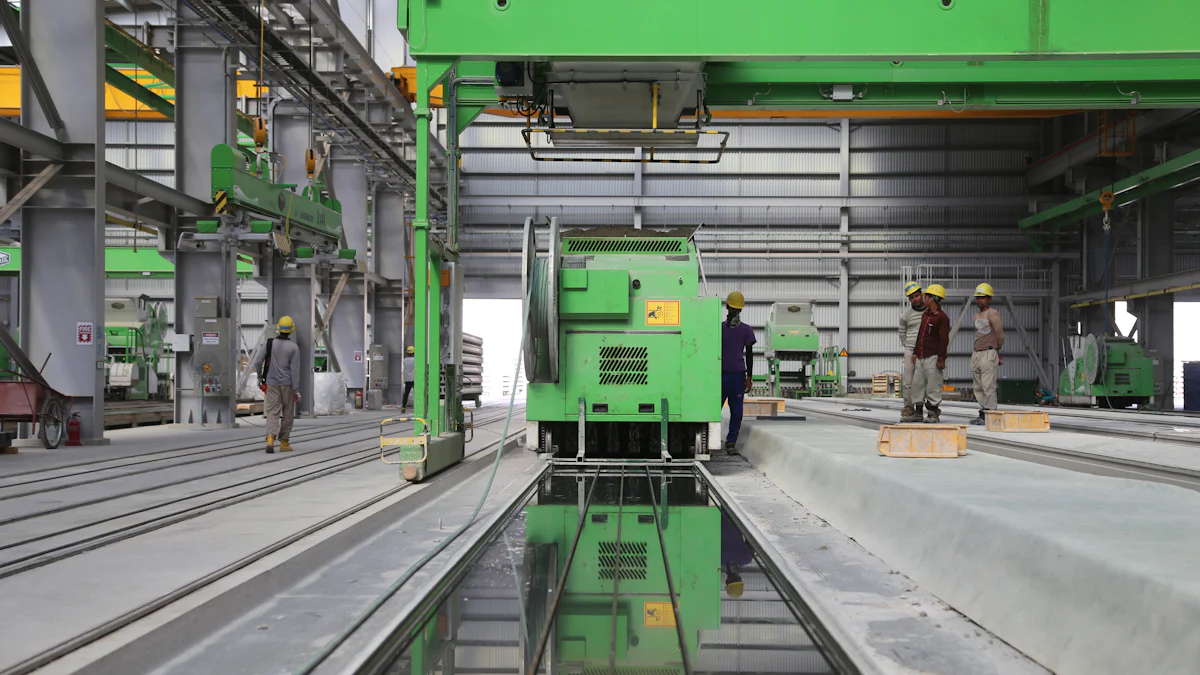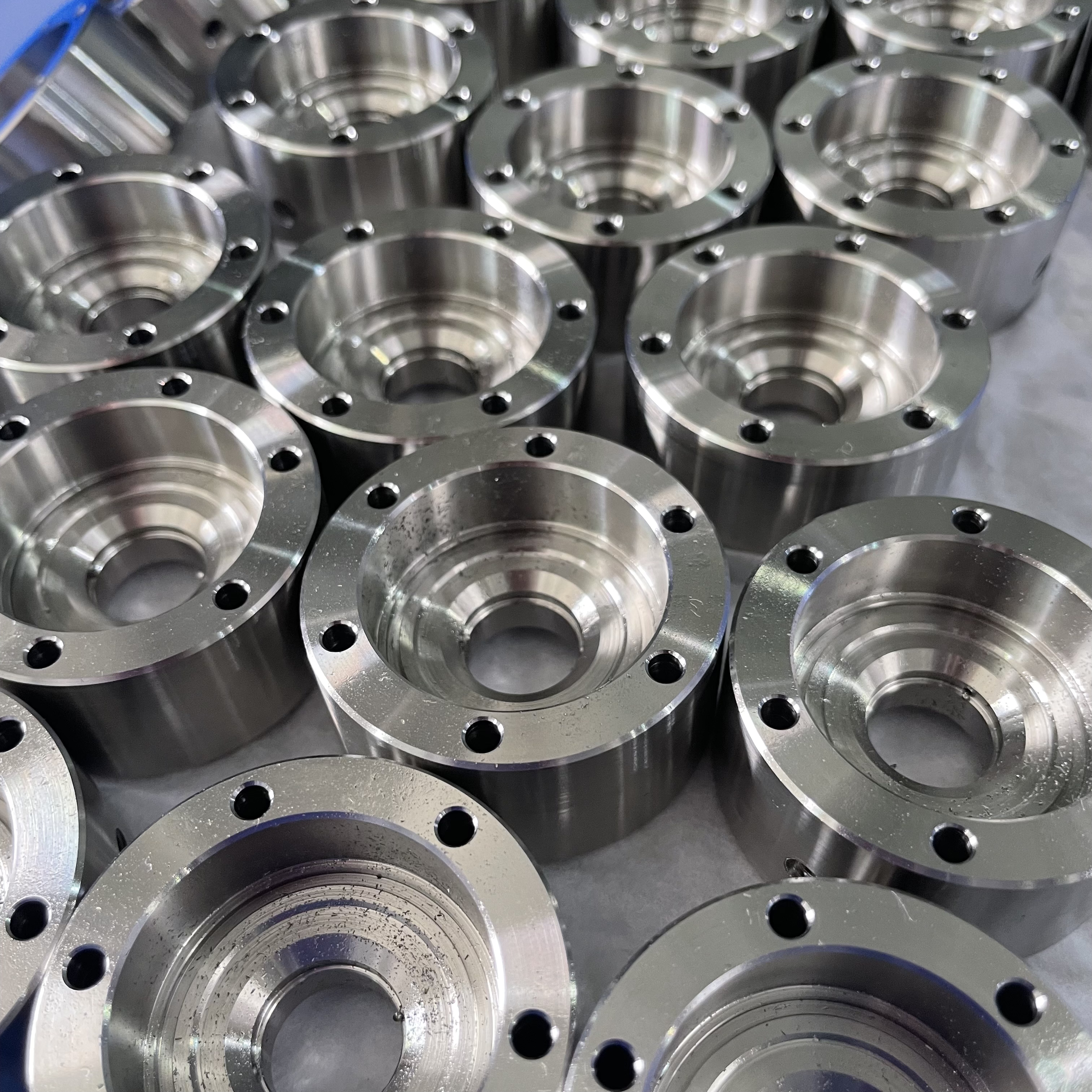How CNC Handles Materials with Low Carbon Footprints

CNC machining plays a vital role in sustainable manufacturing by enabling precise material handling and reducing waste. Unlike traditional methods, CNC machines consume only the energy required for specific tasks, minimizing environmental impact. This precision ensures better resource utilization, which lowers material waste and energy consumption. Many industries now adopt energy-efficient CNC tools to reduce carbon emissions and operational costs. Emerging green technologies, such as renewable energy-powered machines, further enhance eco-friendliness. By combining precision with energy efficiency, CNC machining supports the shift toward sustainable production practices.
Key Takeaways
CNC machining cuts down waste and uses less energy. This helps make manufacturing more eco-friendly.
Using materials with low carbon helps reduce pollution and supports reusing resources.
Improving tool movements and settings saves materials and creates less waste.
Using energy-saving CNC machines and clean energy lowers costs and pollution.
Recycling during CNC work saves materials and helps the environment.
Understanding Low-Carbon Materials
Defining Low-Carbon Materials
Low-carbon materials are essential for reducing the environmental impact of manufacturing. These materials lower both embodied and operational carbon emissions, making them a cornerstone of sustainable practices. They also promote circularity by enabling reuse and recycling, which reduces waste. Unlike conventional materials, low-carbon alternatives aim to create a healthier environment while supporting a circular economy.
Several strategies define these materials. For example, designing them at the atomic or molecular level enhances their circularity. Using local, renewable resources minimizes transportation emissions. Recyclable materials and products designed for longer lifespans further contribute to sustainability. These approaches ensure that low-carbon materials conserve their functional properties while increasing energy efficiency.
Role of Low-Carbon Materials in Sustainable Manufacturing
Incorporating low-carbon materials into manufacturing processes helps you reduce the carbon footprint of your products. These materials align perfectly with CNC machining, which excels at handling eco-friendly options. For instance, waste biomass resources like sawdust or agricultural residue can be processed into durable components. Transparent wood, known for its low thermal conductivity, is another example used in green construction.
By using these materials, you support sustainable manufacturing practices. CNC machining ensures precision and minimizes waste, making it ideal for processing low-carbon materials. This combination allows you to create products that are both functional and environmentally friendly.
Overcoming Challenges in Using Low-Carbon Materials
Adopting low-carbon materials comes with challenges, but you can overcome them with the right strategies. One common issue is the variability in material properties. CNC machining addresses this by offering precise control over machining parameters, ensuring consistent results. Another challenge is sourcing these materials locally. By prioritizing renewable resources, you can reduce transportation emissions and costs.
Processing low-carbon materials efficiently requires advanced technologies. CNC machines equipped with smart automation can optimize toolpaths and reduce energy consumption. These innovations make it easier for you to integrate sustainable materials into your production processes.
CNC Machining for Material Optimization

Precision Machining to Minimize Waste
Precision machining plays a critical role in reducing waste during manufacturing. CNC machining achieves this by removing only the necessary material to create components, ensuring optimized material usage. Unlike traditional methods, CNC machines operate with high accuracy, which minimizes errors and reduces the need for rework. This precision directly contributes to waste reduction and lowers the environmental impact of manufacturing processes.
CNC machining ensures precise material removal, which maximizes material efficiency.
Sustainable CNC machining reduces energy consumption and waste, supporting green manufacturing.
The precision in CNC machining minimizes waste during part crafting, making it ideal for sustainable practices.
By adopting precision machining, you can create high-quality components while conserving materials and energy. This approach aligns with sustainability goals and promotes eco-friendly production.
Toolpath Optimization for Material Efficiency
Optimizing toolpaths is essential for improving material efficiency in CNC machining. Techniques like adaptive clearing use dynamic algorithms to maintain consistent cutting forces, reducing tool wear and enhancing machining performance. Trochoidal milling, another effective method, minimizes vibrations and cutting forces, resulting in smoother finishes and prolonged tool life. These techniques ensure that you achieve optimized material usage while maintaining high-quality results.
Advanced optimization methods, such as genetic algorithms and deep learning, further enhance CNC machining processes. These innovations allow you to reduce material waste and improve efficiency. By implementing these strategies, you can lower emissions and support sustainable practices in your manufacturing operations.
Lean Manufacturing in CNC Processes
Lean manufacturing principles help you eliminate waste and improve efficiency in CNC machining. Just-in-Time (JIT) production ensures that resources are available when needed, reducing waiting times and material waste. Organizing workflows using methods like 5S enhances productivity and minimizes errors. These practices contribute to higher-quality components and streamlined operations.
Lean manufacturing reduces cycle time and material usage.
It eliminates waste and increases efficiency in CNC machining processes.
JIT production minimizes waste and enhances customer satisfaction.
By integrating lean manufacturing principles, you can optimize CNC processes, reduce emissions, and support sustainability in your production.
Energy Efficiency in CNC Machining
Energy-Efficient CNC Machines and Technologies
Energy-efficient machines are transforming CNC machining by reducing power consumption and enhancing productivity. These machines incorporate advanced motor technologies and intelligent power management systems to optimize energy use. For example, regenerative braking systems recover energy during operation, which reduces overall electricity demand. By integrating AI and machine learning algorithms, you can further enhance efficiency. These technologies analyze machining processes in real time, optimizing tool paths and minimizing material waste.
You can also adopt renewable energy sources to power CNC machines. Solar panels or wind turbines can supply clean energy, aligning your operations with green manufacturing goals. Additionally, optimizing production schedules ensures machines operate only when needed, reducing idle time and unnecessary energy use. These advancements not only lower emissions but also demonstrate a commitment to environmental stewardship.
Reducing Carbon Emissions Through Smart Automation
Smart automation in CNC machining plays a crucial role in reducing carbon emissions. Automated systems enhance precision and accuracy, which minimizes waste during production. Sophisticated software like CAD and CAM optimizes manufacturing processes, ensuring efficient material usage and lower energy consumption. By using energy-efficient machinery, you can maintain high output levels while significantly reducing power requirements.
Automation also enables better resource management. For instance, electronic file transmission eliminates the need for physical transportation, further reducing emissions. These innovations allow you to streamline operations while supporting sustainable practices. By adopting smart automation, you can achieve both environmental and economic benefits.
Optimizing Machining Parameters for Sustainability
Optimizing machining parameters is essential for improving sustainability in CNC processes. You can start by selecting eco-friendly materials, which reduce the environmental impact of your components. Accurate CNC programming minimizes material waste, ensuring efficient use of resources. Switching to biodegradable or water-soluble coolants instead of traditional oil-based ones further enhances sustainability.
Recycling systems for metal chips and plastic scraps can also make a significant difference. Advanced simulation software allows you to create virtual models of machining processes, helping you identify inefficiencies before production begins. This proactive approach reduces waste and energy consumption. By implementing these strategies, you can align your operations with sustainable practices while lowering costs.
CNC and Eco-Friendly Material Choices

Machining Recyclable Materials
Recycling plays a vital role in reducing waste and conserving resources in CNC machining. By recycling metal scraps, you can significantly lower the environmental impact of your manufacturing processes. This approach conserves raw materials and requires less energy compared to processing new materials. CNC machines excel at handling recyclable materials, ensuring precision and efficiency during production.
Reduced waste and energy consumption
Cost savings through material reuse
Improved environmental impact
Recycling metal scraps also promotes sustainable development. By incorporating this practice into your operations, you can increase material efficiency and decrease environmental damage. CNC machining ensures that recyclable materials are processed with minimal waste, aligning your efforts with green manufacturing goals.
Supporting Biodegradable and Sustainable Materials
CNC machining supports the use of biodegradable and sustainable materials, helping you create eco-friendly components. Certified biodegradable materials like PLA, derived from renewable sources such as corn or sugarcane, are ideal for CNC applications. These materials work well in scenarios where lower operational stress is involved, ensuring durability without compromising sustainability.
You can also choose biodegradable plastics for part creation or apply eco-friendly coatings using CNC machines. This ensures that the entire product aligns with sustainable practices. The choice of materials significantly impacts the sustainability of your manufacturing process. By opting for green materials, you contribute to a cleaner environment and reduce your carbon footprint.
Innovations in Eco-Friendly CNC Tooling
Recent innovations in CNC tooling enhance precision and reduce waste, making your operations more sustainable. Manufacturers now embrace renewable energy sources like solar and wind power to minimize their carbon footprint. Advanced tooling techniques improve machining accuracy, ensuring efficient material usage and less waste.
The shift toward biodegradable and environmentally friendly materials is another key development. These innovations not only support sustainability but also improve the overall efficiency of CNC machining. By adopting these advancements, you can align your operations with green manufacturing principles and achieve long-term environmental benefits.
Tip: Incorporating eco-friendly tooling and materials into your CNC processes can help you meet sustainability goals while maintaining high-quality production standards.
Real-World Applications of CNC in Sustainable Manufacturing
Automotive Industry: Lightweight and Recyclable Components
CNC machining plays a pivotal role in the automotive industry by enabling the production of lightweight and recyclable components. You can use CNC to process materials like aluminum, which is lighter than steel and enhances vehicle performance. Aluminum components improve acceleration, braking, and handling while contributing to better fuel efficiency. Additionally, aluminum is highly recyclable, conserving resources and significantly reducing emissions compared to steel-based parts.
CNC machining allows you to utilize recycled materials for part production.
Excess material from the machining process can be recycled to create additional parts.
This practice supports a circular economy, enhancing sustainability in manufacturing.
By adopting CNC machining, you can reduce the carbon footprint of automotive production while maintaining high-quality standards. This approach aligns with the industry's growing focus on eco-friendly practices.
Aerospace: Precision and Reduced Carbon Footprint
In the aerospace sector, CNC machining ensures precision while reducing the carbon footprint of manufacturing processes. Aircraft components require extreme accuracy, and CNC machines excel in delivering this level of detail. You can use CNC to create lightweight parts, which reduce fuel consumption and emissions during flight. For example, machining titanium and composite materials helps you achieve the strength-to-weight ratio needed for aerospace applications.
CNC machining also minimizes waste by removing only the necessary material. This precision reduces the need for rework, saving energy and resources. By integrating CNC into aerospace manufacturing, you contribute to a more sustainable future while meeting the industry's stringent quality requirements.
Consumer Goods: Eco-Friendly Product Design
CNC machining supports eco-friendly product design in the consumer goods industry. By optimizing resource utilization, you can reduce waste and lower energy consumption throughout the machining process. For example, advanced CAM software ensures precise material removal, minimizing scrap and improving material efficiency. This approach not only conserves resources but also aligns with sustainable manufacturing goals.
Sustainable Practice | Contribution to Eco-Friendliness |
|---|---|
Material Efficiency | Reduces waste through precise control over material removal. |
Energy Conservation | Advanced CAM software optimizes material usage, minimizing scrap. |
You can also adopt AI and machine learning for predictive maintenance. These technologies reduce downtime, boost productivity, and ensure precise machine performance with lower energy consumption. By incorporating CNC machining into your operations, you can create eco-friendly products that meet consumer demand for sustainability.
Companies Leading in CNC Sustainability
Several companies are setting benchmarks in sustainable CNC practices. These organizations demonstrate how you can integrate eco-friendly innovations into your operations while maintaining high-quality standards.
Siemens: Siemens leads the way in sustainable CNC machining. The company develops energy-efficient CNC systems that reduce power consumption. Their Sinumerik CNC controllers optimize machining processes, ensuring minimal waste and maximum precision. By adopting Siemens' solutions, you can enhance productivity while lowering your environmental impact.
DMG Mori: DMG Mori focuses on green manufacturing by designing CNC machines with reduced energy requirements. Their CELOS system integrates digital tools to monitor and optimize energy use. This approach helps you streamline operations and achieve sustainability goals without compromising performance.
Haas Automation: Haas Automation emphasizes recycling and waste reduction in CNC machining. The company uses advanced technologies to recycle metal chips and other byproducts. Their machines also feature energy-saving modes, allowing you to minimize electricity usage during idle times.
Mazak: Mazak incorporates renewable energy into its manufacturing facilities. Their hybrid CNC machines combine additive and subtractive machining, reducing material waste. By using Mazak's innovative solutions, you can improve efficiency and support sustainable practices.
Sandvik Coromant: Sandvik Coromant develops eco-friendly tooling solutions for CNC machining. Their tools use recyclable materials and advanced coatings to extend tool life. These innovations help you reduce waste and improve machining efficiency.
Note: Partnering with these companies can help you adopt sustainable CNC practices and contribute to a greener future.
CNC machining plays a crucial role in advancing sustainable manufacturing. It reduces raw material waste through precision cutting, conserving resources and lowering energy consumption. Energy-efficient machines and recycling practices transform scrap into valuable materials, further minimizing the carbon footprint. By optimizing resource utilization and integrating eco-friendly processes, you align your operations with global sustainability goals. These advancements not only conserve natural resources but also promote responsible manufacturing practices. As industries continue to adopt sustainable methods, CNC machining will remain a driving force behind eco-friendly innovation and production.
FAQ
What are low-carbon materials, and why should you use them?
Low-carbon materials reduce greenhouse gas emissions during production and usage. They promote sustainability by conserving resources and enabling recycling. Using these materials helps you lower your environmental impact while meeting growing consumer demand for eco-friendly products.
How does CNC machining support sustainable manufacturing?
CNC machining minimizes waste through precision cutting and optimized toolpaths. It uses energy-efficient machines and supports recyclable and biodegradable materials. These features allow you to create high-quality components while reducing your carbon footprint.
Can CNC machines handle biodegradable materials effectively?
Yes, CNC machines can process biodegradable materials like PLA with precision. These materials work well for creating durable, eco-friendly components. By using CNC machining, you ensure efficient material usage and align your production with sustainability goals.
What industries benefit most from sustainable CNC machining?
Industries like automotive, aerospace, and consumer goods benefit significantly. CNC machining helps you create lightweight, recyclable components for vehicles, precise parts for aircraft, and eco-friendly designs for everyday products. These applications reduce emissions and support green manufacturing.
How can you make your CNC processes more energy-efficient?
You can adopt energy-efficient machines, optimize machining parameters, and use renewable energy sources. Smart automation and predictive maintenance also reduce energy consumption. These strategies help you lower costs and align your operations with sustainability goals.
Tip: Regularly monitor your CNC systems to identify inefficiencies and improve energy usage.
See Also
Grasping Material Needs for CNC Precision Machining
Exploring Eco-Friendly Methods in CNC Cutting Fluid Filtration
Become Proficient in CNC Machining: Technical Drawing and Material Choices
Enhancing Processing Excellence Through CNC Precision Machining
CNC Precision Parts Production: Impacting Manufacturing Expenses
About US
Follow Us
Your prototype holds unparalleled significance, and we deeply value its uniqueness. Collaborating with you during the preparation phase for running your prototype or parts is a commitment we gladly embrace. Whether it's a single part or a complex assembly, we are dedicated to selecting the optimal tools and pathways to bring your envisioned product to life.
At Precision Fab CNC Machining, we specialize in producing parts for prototypes, short runs, and high-volume production. Our prototyping machine capabilities extend across metal, plastic, and wood machining, with welding fabrication services available to complement and finalize your prototype if required.
Address
Address: Room320 10F, Building A,Nanshan international building, Dayawan District, Huizhou, Guangdong, 516001 China
Contacts
billy@timaycnc.com

